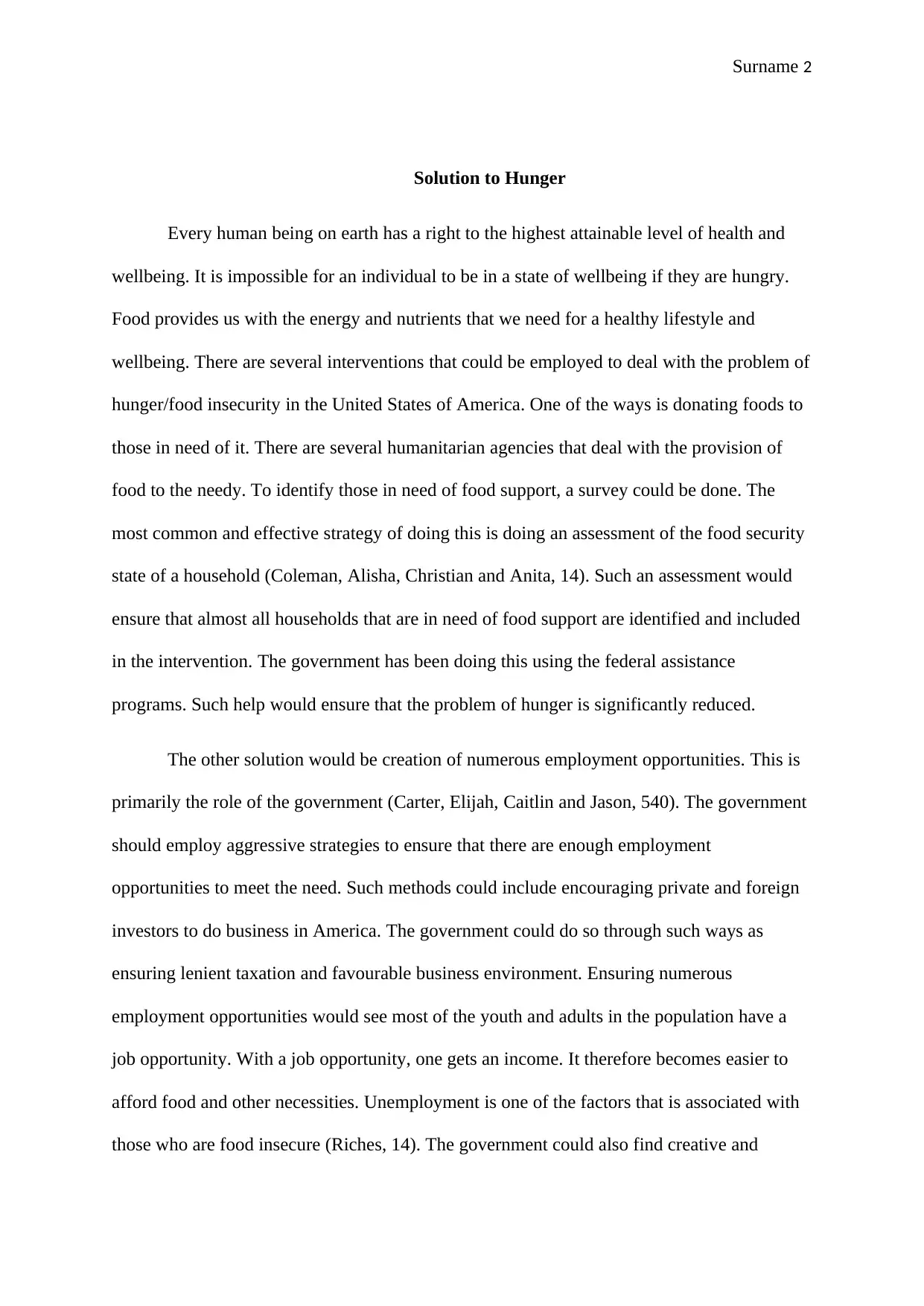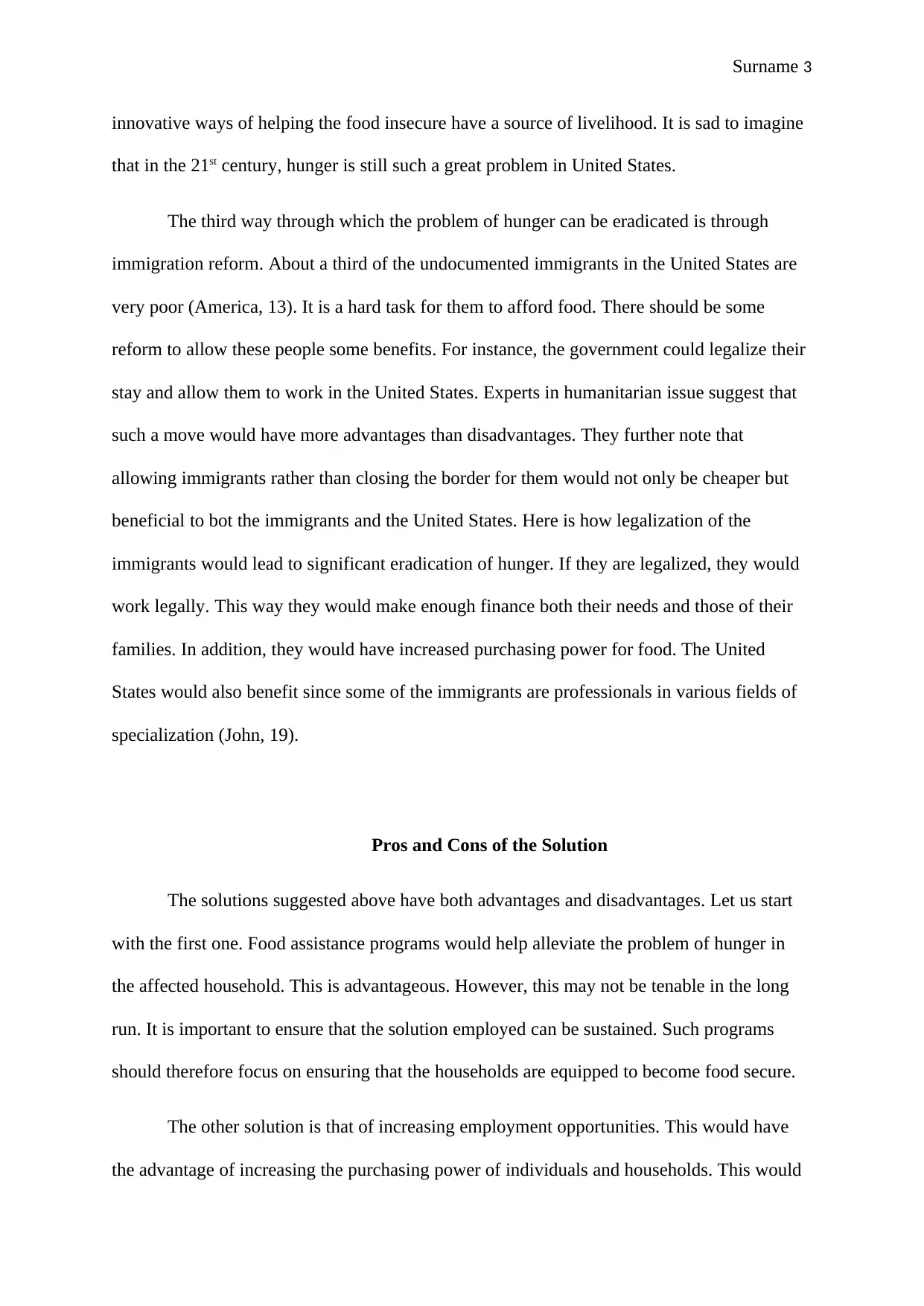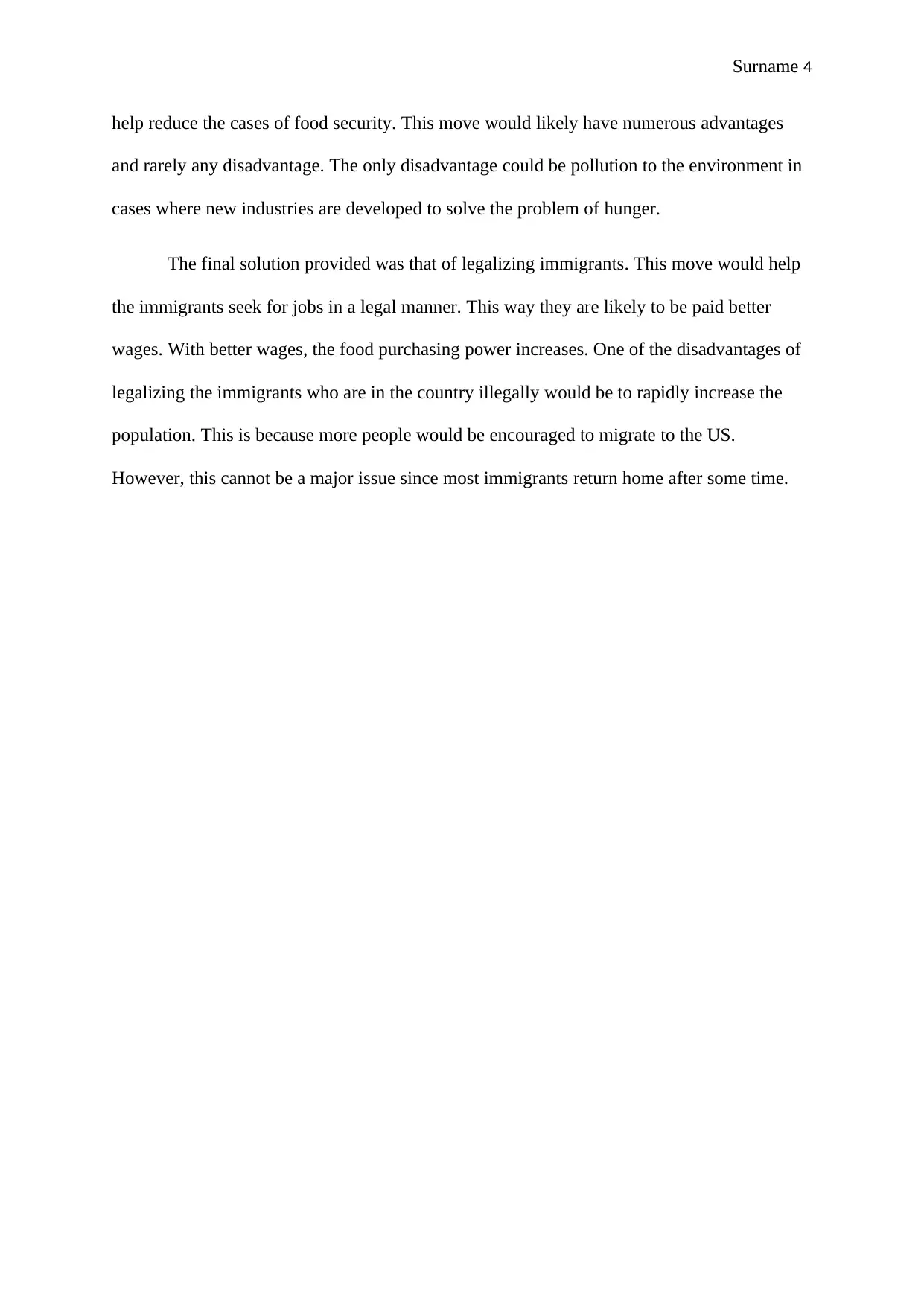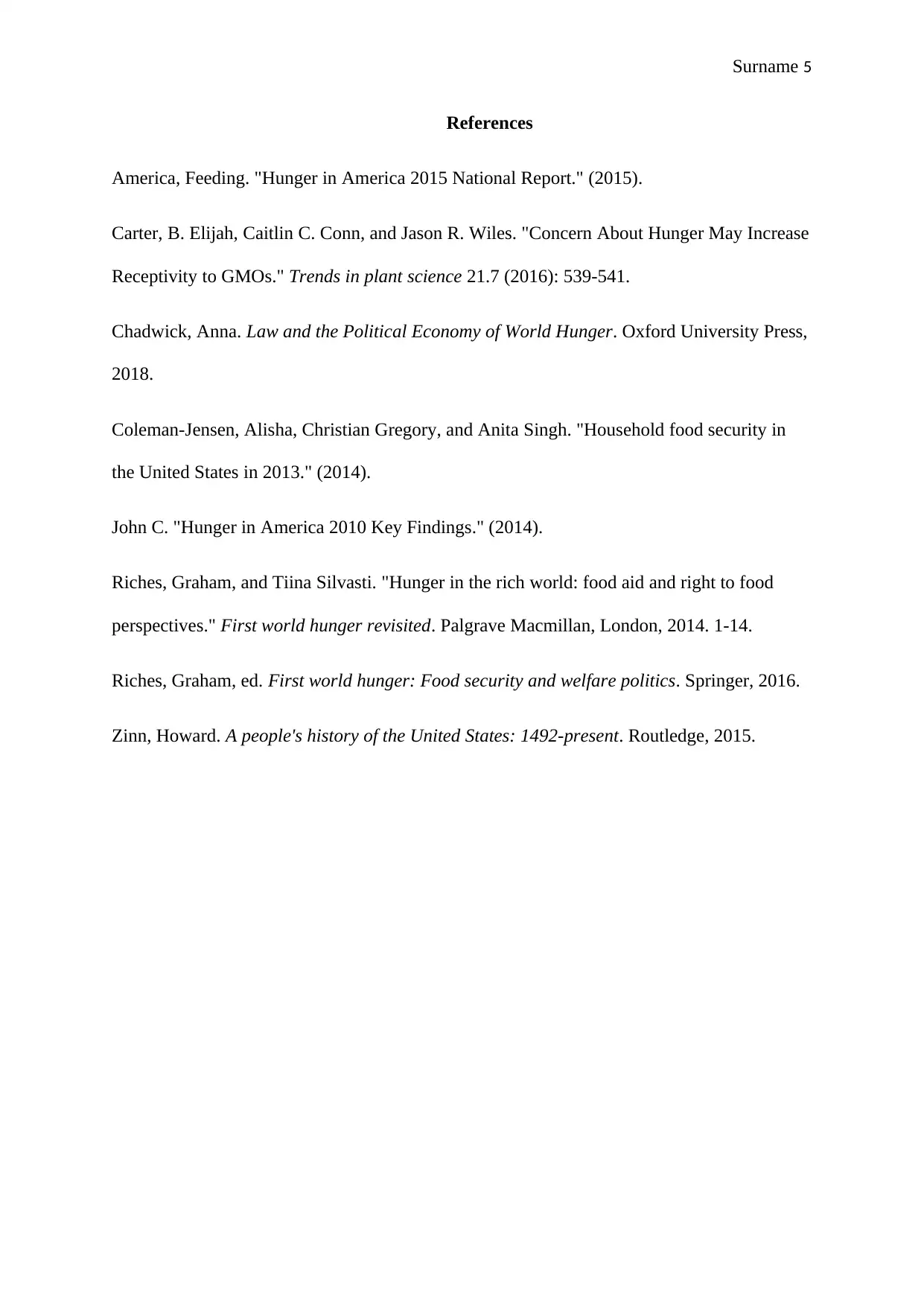Examining Hunger in the US: Federal Programs and Solutions Explored
VerifiedAdded on 2023/05/28
|5
|1366
|356
Essay
AI Summary
This essay delves into the critical issue of hunger and food insecurity in the United States, highlighting the paradox of a nation with high agricultural production struggling with widespread hunger. It cites statistics indicating that millions of Americans, including a significant number of children, face food insecurity, leading to poor health outcomes. The essay proposes several solutions, including food donation programs, creation of employment opportunities through government initiatives and private sector encouragement, and immigration reform to legalize undocumented immigrants, thereby improving their access to employment and food. Each solution is evaluated for its pros and cons, emphasizing the need for sustainable, long-term strategies to ensure food security and well-being for all residents of the United States. The essay concludes by advocating for a multi-faceted approach involving government, humanitarian organizations, and policy changes to address this persistent problem.

Surname 1
Name
Institution
Course
Date
Hunger in the United States
The United States is one of the largest food producers in the world (Chadwick, 7).
The country has employed modern methods of agriculture to maximize agricultural
production. There are well established farming techniques and the production per capita is the
highest in the world. With this information, one might be tempted to think that the almost
everyone in the United States is food secure. Unfortunately, this is not the case. According to
the Food and Agriculture Organization, food security refers to a situation where all people
have access to adequate, safe and nutritious foods at all times (Riches, Graham and Tiina,
14). Hunger is often associate with food insecurity. The issue of hunger and food security is
important not only in America but also at the global level. This explains why one of the
sustainable development goals of the United Nations’ Development Programme is to
eradicate hunger.
According to a recent study, about 40 million Americans are struggling with hunger
(Zinn, 6). It is sad to note that more than 12 million of this number are children (Zinn, 7).
This means that there are numerous household that are food insecure. Being food insecure
means that they do not have access to adequate, safe and nutritious foods to meet their dietary
needs. This predisposes them to poor health since they are not getting adequate nutrients
needed for proper growth, development and immunity. The study also found out that
households with children have a higher risk of being food insecure. In addition, about 58% of
the food insecure households were enrolled to at least one of the federal assistance programs.
Name
Institution
Course
Date
Hunger in the United States
The United States is one of the largest food producers in the world (Chadwick, 7).
The country has employed modern methods of agriculture to maximize agricultural
production. There are well established farming techniques and the production per capita is the
highest in the world. With this information, one might be tempted to think that the almost
everyone in the United States is food secure. Unfortunately, this is not the case. According to
the Food and Agriculture Organization, food security refers to a situation where all people
have access to adequate, safe and nutritious foods at all times (Riches, Graham and Tiina,
14). Hunger is often associate with food insecurity. The issue of hunger and food security is
important not only in America but also at the global level. This explains why one of the
sustainable development goals of the United Nations’ Development Programme is to
eradicate hunger.
According to a recent study, about 40 million Americans are struggling with hunger
(Zinn, 6). It is sad to note that more than 12 million of this number are children (Zinn, 7).
This means that there are numerous household that are food insecure. Being food insecure
means that they do not have access to adequate, safe and nutritious foods to meet their dietary
needs. This predisposes them to poor health since they are not getting adequate nutrients
needed for proper growth, development and immunity. The study also found out that
households with children have a higher risk of being food insecure. In addition, about 58% of
the food insecure households were enrolled to at least one of the federal assistance programs.
Paraphrase This Document
Need a fresh take? Get an instant paraphrase of this document with our AI Paraphraser

Surname 2
Solution to Hunger
Every human being on earth has a right to the highest attainable level of health and
wellbeing. It is impossible for an individual to be in a state of wellbeing if they are hungry.
Food provides us with the energy and nutrients that we need for a healthy lifestyle and
wellbeing. There are several interventions that could be employed to deal with the problem of
hunger/food insecurity in the United States of America. One of the ways is donating foods to
those in need of it. There are several humanitarian agencies that deal with the provision of
food to the needy. To identify those in need of food support, a survey could be done. The
most common and effective strategy of doing this is doing an assessment of the food security
state of a household (Coleman, Alisha, Christian and Anita, 14). Such an assessment would
ensure that almost all households that are in need of food support are identified and included
in the intervention. The government has been doing this using the federal assistance
programs. Such help would ensure that the problem of hunger is significantly reduced.
The other solution would be creation of numerous employment opportunities. This is
primarily the role of the government (Carter, Elijah, Caitlin and Jason, 540). The government
should employ aggressive strategies to ensure that there are enough employment
opportunities to meet the need. Such methods could include encouraging private and foreign
investors to do business in America. The government could do so through such ways as
ensuring lenient taxation and favourable business environment. Ensuring numerous
employment opportunities would see most of the youth and adults in the population have a
job opportunity. With a job opportunity, one gets an income. It therefore becomes easier to
afford food and other necessities. Unemployment is one of the factors that is associated with
those who are food insecure (Riches, 14). The government could also find creative and
Solution to Hunger
Every human being on earth has a right to the highest attainable level of health and
wellbeing. It is impossible for an individual to be in a state of wellbeing if they are hungry.
Food provides us with the energy and nutrients that we need for a healthy lifestyle and
wellbeing. There are several interventions that could be employed to deal with the problem of
hunger/food insecurity in the United States of America. One of the ways is donating foods to
those in need of it. There are several humanitarian agencies that deal with the provision of
food to the needy. To identify those in need of food support, a survey could be done. The
most common and effective strategy of doing this is doing an assessment of the food security
state of a household (Coleman, Alisha, Christian and Anita, 14). Such an assessment would
ensure that almost all households that are in need of food support are identified and included
in the intervention. The government has been doing this using the federal assistance
programs. Such help would ensure that the problem of hunger is significantly reduced.
The other solution would be creation of numerous employment opportunities. This is
primarily the role of the government (Carter, Elijah, Caitlin and Jason, 540). The government
should employ aggressive strategies to ensure that there are enough employment
opportunities to meet the need. Such methods could include encouraging private and foreign
investors to do business in America. The government could do so through such ways as
ensuring lenient taxation and favourable business environment. Ensuring numerous
employment opportunities would see most of the youth and adults in the population have a
job opportunity. With a job opportunity, one gets an income. It therefore becomes easier to
afford food and other necessities. Unemployment is one of the factors that is associated with
those who are food insecure (Riches, 14). The government could also find creative and

Surname 3
innovative ways of helping the food insecure have a source of livelihood. It is sad to imagine
that in the 21st century, hunger is still such a great problem in United States.
The third way through which the problem of hunger can be eradicated is through
immigration reform. About a third of the undocumented immigrants in the United States are
very poor (America, 13). It is a hard task for them to afford food. There should be some
reform to allow these people some benefits. For instance, the government could legalize their
stay and allow them to work in the United States. Experts in humanitarian issue suggest that
such a move would have more advantages than disadvantages. They further note that
allowing immigrants rather than closing the border for them would not only be cheaper but
beneficial to bot the immigrants and the United States. Here is how legalization of the
immigrants would lead to significant eradication of hunger. If they are legalized, they would
work legally. This way they would make enough finance both their needs and those of their
families. In addition, they would have increased purchasing power for food. The United
States would also benefit since some of the immigrants are professionals in various fields of
specialization (John, 19).
Pros and Cons of the Solution
The solutions suggested above have both advantages and disadvantages. Let us start
with the first one. Food assistance programs would help alleviate the problem of hunger in
the affected household. This is advantageous. However, this may not be tenable in the long
run. It is important to ensure that the solution employed can be sustained. Such programs
should therefore focus on ensuring that the households are equipped to become food secure.
The other solution is that of increasing employment opportunities. This would have
the advantage of increasing the purchasing power of individuals and households. This would
innovative ways of helping the food insecure have a source of livelihood. It is sad to imagine
that in the 21st century, hunger is still such a great problem in United States.
The third way through which the problem of hunger can be eradicated is through
immigration reform. About a third of the undocumented immigrants in the United States are
very poor (America, 13). It is a hard task for them to afford food. There should be some
reform to allow these people some benefits. For instance, the government could legalize their
stay and allow them to work in the United States. Experts in humanitarian issue suggest that
such a move would have more advantages than disadvantages. They further note that
allowing immigrants rather than closing the border for them would not only be cheaper but
beneficial to bot the immigrants and the United States. Here is how legalization of the
immigrants would lead to significant eradication of hunger. If they are legalized, they would
work legally. This way they would make enough finance both their needs and those of their
families. In addition, they would have increased purchasing power for food. The United
States would also benefit since some of the immigrants are professionals in various fields of
specialization (John, 19).
Pros and Cons of the Solution
The solutions suggested above have both advantages and disadvantages. Let us start
with the first one. Food assistance programs would help alleviate the problem of hunger in
the affected household. This is advantageous. However, this may not be tenable in the long
run. It is important to ensure that the solution employed can be sustained. Such programs
should therefore focus on ensuring that the households are equipped to become food secure.
The other solution is that of increasing employment opportunities. This would have
the advantage of increasing the purchasing power of individuals and households. This would
⊘ This is a preview!⊘
Do you want full access?
Subscribe today to unlock all pages.

Trusted by 1+ million students worldwide

Surname 4
help reduce the cases of food security. This move would likely have numerous advantages
and rarely any disadvantage. The only disadvantage could be pollution to the environment in
cases where new industries are developed to solve the problem of hunger.
The final solution provided was that of legalizing immigrants. This move would help
the immigrants seek for jobs in a legal manner. This way they are likely to be paid better
wages. With better wages, the food purchasing power increases. One of the disadvantages of
legalizing the immigrants who are in the country illegally would be to rapidly increase the
population. This is because more people would be encouraged to migrate to the US.
However, this cannot be a major issue since most immigrants return home after some time.
help reduce the cases of food security. This move would likely have numerous advantages
and rarely any disadvantage. The only disadvantage could be pollution to the environment in
cases where new industries are developed to solve the problem of hunger.
The final solution provided was that of legalizing immigrants. This move would help
the immigrants seek for jobs in a legal manner. This way they are likely to be paid better
wages. With better wages, the food purchasing power increases. One of the disadvantages of
legalizing the immigrants who are in the country illegally would be to rapidly increase the
population. This is because more people would be encouraged to migrate to the US.
However, this cannot be a major issue since most immigrants return home after some time.
Paraphrase This Document
Need a fresh take? Get an instant paraphrase of this document with our AI Paraphraser

Surname 5
References
America, Feeding. "Hunger in America 2015 National Report." (2015).
Carter, B. Elijah, Caitlin C. Conn, and Jason R. Wiles. "Concern About Hunger May Increase
Receptivity to GMOs." Trends in plant science 21.7 (2016): 539-541.
Chadwick, Anna. Law and the Political Economy of World Hunger. Oxford University Press,
2018.
Coleman-Jensen, Alisha, Christian Gregory, and Anita Singh. "Household food security in
the United States in 2013." (2014).
John C. "Hunger in America 2010 Key Findings." (2014).
Riches, Graham, and Tiina Silvasti. "Hunger in the rich world: food aid and right to food
perspectives." First world hunger revisited. Palgrave Macmillan, London, 2014. 1-14.
Riches, Graham, ed. First world hunger: Food security and welfare politics. Springer, 2016.
Zinn, Howard. A people's history of the United States: 1492-present. Routledge, 2015.
References
America, Feeding. "Hunger in America 2015 National Report." (2015).
Carter, B. Elijah, Caitlin C. Conn, and Jason R. Wiles. "Concern About Hunger May Increase
Receptivity to GMOs." Trends in plant science 21.7 (2016): 539-541.
Chadwick, Anna. Law and the Political Economy of World Hunger. Oxford University Press,
2018.
Coleman-Jensen, Alisha, Christian Gregory, and Anita Singh. "Household food security in
the United States in 2013." (2014).
John C. "Hunger in America 2010 Key Findings." (2014).
Riches, Graham, and Tiina Silvasti. "Hunger in the rich world: food aid and right to food
perspectives." First world hunger revisited. Palgrave Macmillan, London, 2014. 1-14.
Riches, Graham, ed. First world hunger: Food security and welfare politics. Springer, 2016.
Zinn, Howard. A people's history of the United States: 1492-present. Routledge, 2015.
1 out of 5
Related Documents
Your All-in-One AI-Powered Toolkit for Academic Success.
+13062052269
info@desklib.com
Available 24*7 on WhatsApp / Email
![[object Object]](/_next/static/media/star-bottom.7253800d.svg)
Unlock your academic potential
Copyright © 2020–2025 A2Z Services. All Rights Reserved. Developed and managed by ZUCOL.





